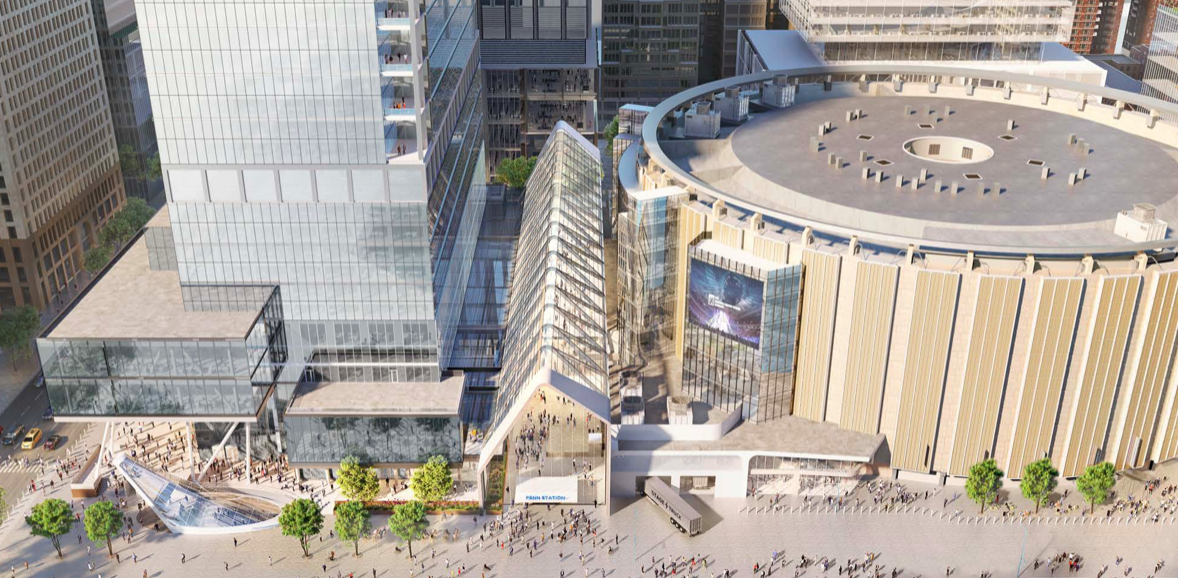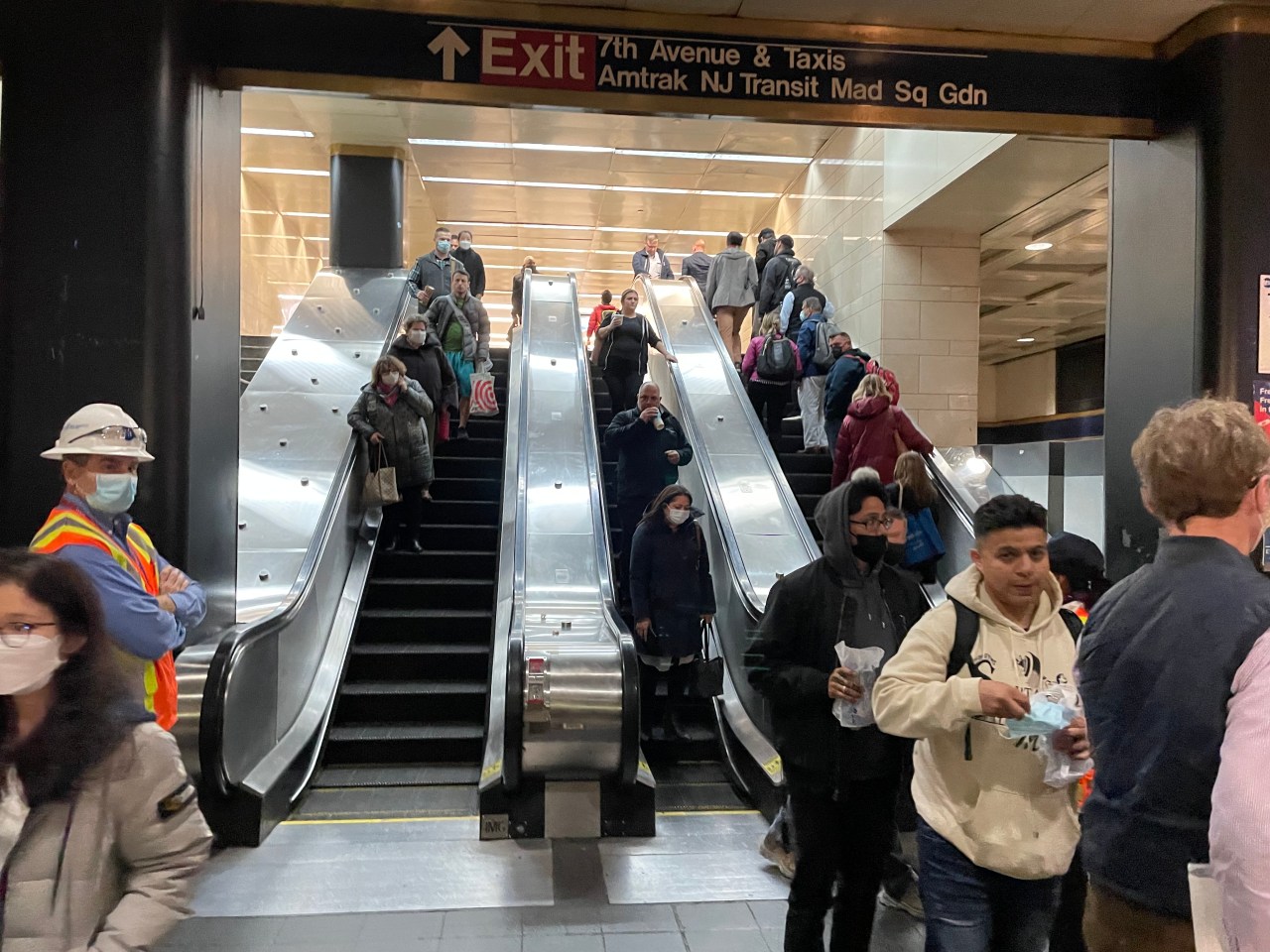ANALYSIS: Hochul’s New Penn Station Will Be Pleasant To Walk Through, But Won’t Add Train Capacity

Gov. Hochul’s announcement on Wednesday that New York was building a “Penn Station worthy of New Yorkers” had the pomp and circumstance of a can’t-miss infrastructural announcement, but beyond a billion-dollar facelift, advocates say riders will have to keep waiting for more train service.
“Your commute should not be a daily grind when you’re coming in from Brooklyn, Manhattan, Queens, Long Island, and soon, with Penn Access, from the Bronx and Westchester,” Hochul said as she hyped up the plan to transform Penn Station from a dark subterranean pit to an airy train hall.
When the recently revealed plan is finished, Penn will have a single floor above its boarding platforms instead of the two floor layout that limits ceiling height on its main concourse. But while the cosmetic improvements will make Penn a more pleasant place, advocates say that it’s still not a game changer for transit service into and out of Midtown Manhattan.
“If you are a transit rider in the region, you’re not going to be much better off than you were,” said Tri-State Transportation Campaign Director of Regional Infrastructure Projects Felicia Park-Rogers. “You’ll have a more pleasant space to walk in and out of, but there’s nothing being done in that scenario that improves the actual transit.”
All aboard
Hochul’s plan is one that’s less Robert Moses and more Bjarke Ingels, focusing on the (relatively) smaller task of turning Penn Station from an underground pit to a slightly less pit-like train hall. The refurbishment, which was developed by the MTA, will seek to open up Penn Station by giving it a single level above the train platforms, instead of the current two levels above the platforms. Getting in to the station will also be made more convenient through the addition of 18 more escalators and 11 more elevators.

As it currently exists, Penn commuters who need to board a train at the station have to walk down two concourses to reach the boarding platform. That multi-level layout reduces the amount of overhead space on either the first or second floor, which contributes to the packed and dark atmosphere in the current station.

To bring light to the darkness, the MTA will remove the upper level where some scattered retail and an Amtrak waiting area currently exist. A 450-foot skylight will be installed where an unused taxi stand now sits on 32nd Street between Seventh and Eighth avenues. According to Hochul, when the new one-level concourse is complete, it will have more floor space than Moynihan Train Hall and Grand Central Station combined.
The street beat
Above ground, the new plan is to build an internal loading dock for Madison Square Garden — the Dolan House of Horrors that some thinkers have suggested moving elsewhere to create an even better Penn Station — so that trucks can load into the building off of the street. The plan also recommends that the DOT create three shared streets in the area: one on West 31st between Seventh and Eighth Avenue, one on 32nd Street between 6th and 7th avenues and one on 33rd Street stretching from Sixth to Ninth avenues. Bike parking, always a problem in the city, will be included as well, though the governor didn’t mention how many spaces are being added. The public will also get an additional eight acres of space to lounge and hang out on, and wider sidewalks on which to jostle for space and tell each other they’re walkin’ here.
The Hochul plan also calls for the construction of 1,800 apartment units, with 30 percent of them set aside for affordable housing. But ultimately, Wednesday’s announcement kicks the can on the question of how to actually get more trains into midtown Manhattan.
A little history
Prior to resigning in disgrace after numerous corroborated allegations of sexual harassment, Gov. Cuomo had pitched a total remake of the area around Penn Station that he called the Empire Station Complex. That project would have combined improving Penn Station with building eight new tracks to the south and a station known as Penn South. The idea for the new station was to create room more room for New Jersey Transit, which will be able to increase its own train capacity once the Gateway project doubles the amount of tunnels crossing the Hudson River from two to four.
However, Cuomo’s main focus wth the Empire Station Complex was a wholesale redevelopment of the blocks around Penn Station, under the idea that taxes from ten new commercial office towers around the train hub would be used to finance Penn South. But that plan relied heavily on using eminent domain and on the state’s Empire State Development Corporation taking control of the land and development rules around Penn Station under a process known as a General Project Plan, leading critics to accuse the state of a land grab that didn’t even guarantee full funding for the transit improvements.
Although Wednesday’s plan is relatively stripped down compared to what Cuomo sought with his plan, Hochul’s embrace of the MTA’s focus on fixing Penn Station takes care of one pressing need that threatened to be swallowed by the larger political fight over the Empire Station Complex and how exactly to get the MTA, Amtrak and NJ Transit to agree on a plan to increase train capacity at Penn.
“New York State can only do so much and they’re prioritizing the things that they can actually take action on,” said Regional Plan Association Campaign Manager for Build Gateway Now Brian Fritsch. “And the expansion piece which is really part of the Gateway program and part of Amtrak’s plans for the long term is something that they’re doing the bulk of the work on. So it’s not surprising that these two are moving simultaneously but on slightly different courses.”
Capacity is king
In addition to the political argument over whether to add the 10 new skyscrapers to Midtown, advocates were split as to how the actual capacity issues at Penn should get solved. The future of Penn South is not included exactly in the plan, but the state is still expecting that the additional tracks will eventually be built. However, that project would also need its own environmental review to compare it to other possible alternatives.
In particular, some advocates have made the case that instead of building more tracks and a new station, the MTA, Amtrak and New Jersey Transit should work together to create a more unified regional rail system by instituting through running at Penn Station. In that vision, instead of Penn Station acting as a last stop for trains coming from the Jersey, Connecticut and Long Island suburbs, those trains could continue to travel east or west, theoretically unlocking new travel patterns for mass transit users. Advocates for through running are asking that at the very least, the issue is given a comprehensive study and not just a cursory glance.
“At Tri-State, what we would like is a thorough cost benefit analysis of the options for increasing capacity and improving reliability at Penn Station. And that includes taking a serious look at through running, widening platforms and decreasing headways through the station. We think that there is ability to greatly improve capacity, save money and improve the rider experience through through running, and it at least deserves a careful examination in comparison with the very expensive Penn expansion project,” said Rogers.
However, in addition to renovating the boarding platforms underneath Penn Station, through running would require much more political cooperation between the region’s transit entities one everything from rolling stock to work rules. The transit agencies themselves have also downplayed how realistic it would be to implement the switch to an expanded regional rail system, and have coalesced around a southern expansion for new tracks for NJ Transit to use when Gateway is finally finished in 2035.
“If through running worked, that would be great,” said Fritsch. “But this is one case where all the agencies, MTA, Amtrak, and New Jersey Transit, agree that the expansion is necessary to unlock the capacity potential of Gateways. You know how rare it is for all three of those agencies to see eye-to-eye on something, and they all agree that the expansion is necessary.”





